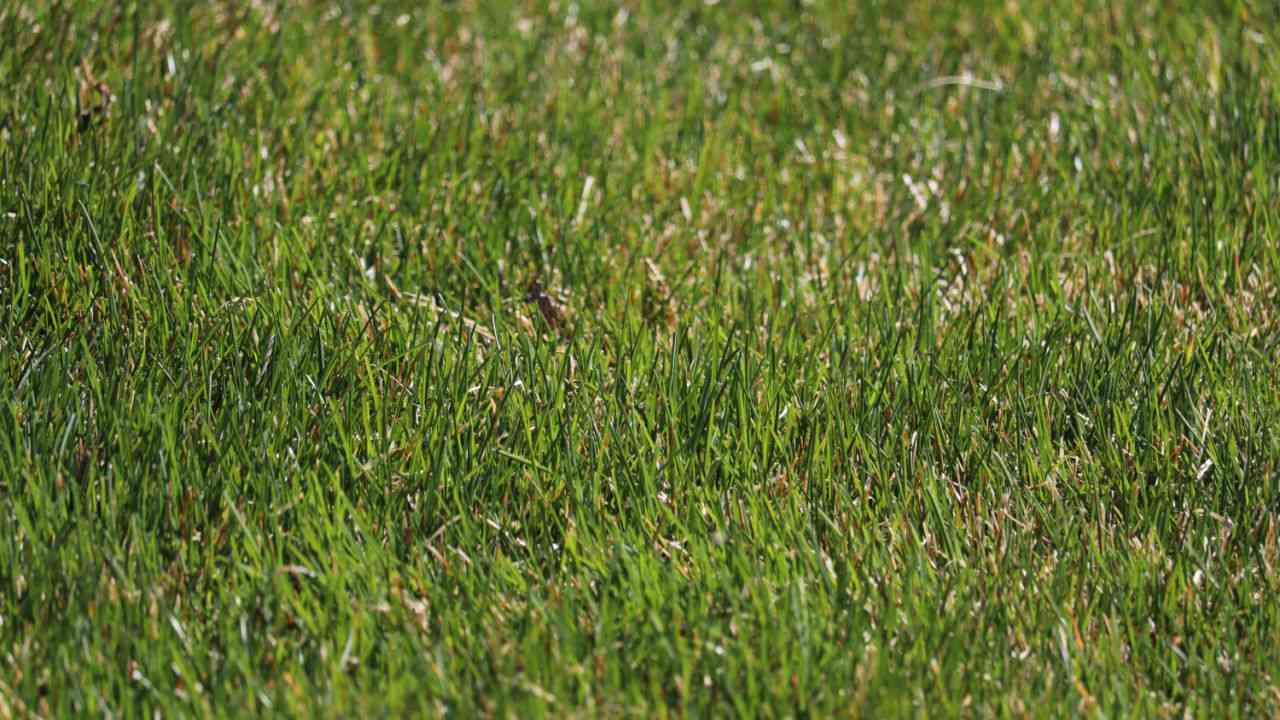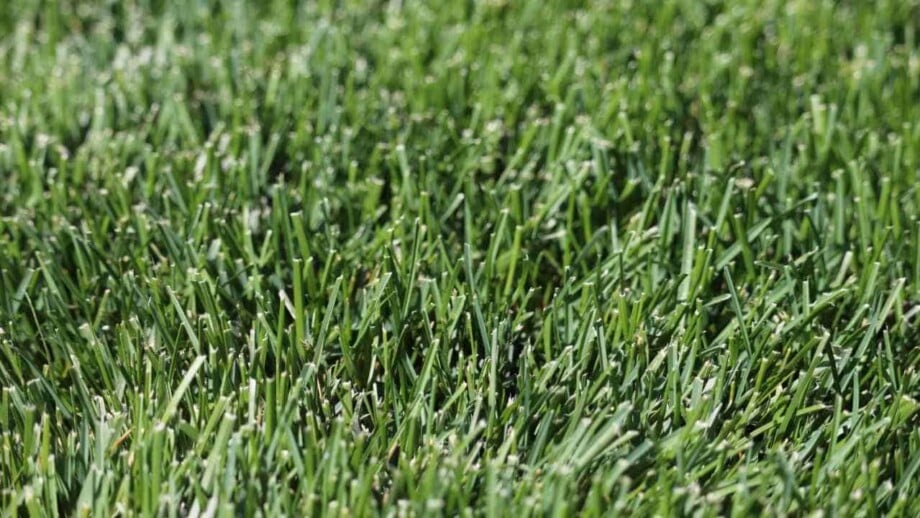Kentucky Bluegrass, scientifically known as Poa pratensis, is a perennial species of grass native to Europe, North Asia, and parts of Africa. As a popular and widely used cool-season grass, it thrives the most during the fall and spring seasons.
Its beautiful deep blue-green color, excellent cold tolerance, and ability to form a uniform sod through rhizome growth make Kentucky Bluegrass a favorite choice for northern lawns across America. It was first used in the US as a pasture grass in states like Kentucky, and is often referred to by its initials KGB.
I’ve learned that caring for Kentucky Bluegrass involves planting it at the right time, usually late summer or early fall, when temperatures become moderate, and rainfall increases. A seeding rate of 10 to 14 pounds per acre ensures quicker ground coverage, although it may take slightly longer to establish than other cool-season grasses.
Its medium fine texture and resilience make it the ideal ‘barefoot’ grass for hours of sports or running around with kids and pets.
What’s best is that Kentucky bluegrass has an excellent capacity for self repair as compared to other cool-season grasses. It can recover quickly from drought-induced periods of dormancy with adequate irrigation or rainfall.
This grass creates a dense, lush, durable lawn that lives up to its reputation when grown in its ideal conditions and given the proper care. However, Kentucky bluegrass cannot accomplish it alone.
This grass requires a moderate amount of upkeep to look its best, but the results can be worthwhile. Depending on where you live and what you want from your lawn, Kentucky bluegrass may be the perfect choice.
In this article, I’ll explore the benefits of growing Kentucky Bluegrass in your lawn, and how share exactly how to care for it to get the best dense turf that has a stunning blue-green color. I’ll also share exactly how and when to plant it for the best results.

Botanical Name: Poa pratensis
Common Name: Kentucky Bluegrass, Common Meadow-grass
Family: Poaceae
Plant Type: Perennial grass
Hardiness Zones: 3 – 9 (USDA)
Sun Exposure: Full sun, partial shade
Soil Type: Well-drained, moist
Soil pH: 6.0 – 7.5
Native Area: Europe, Northern Asia, Africa
Pros and Cons of Kentucky Bluegrass
Benefits of Kentucky Bluegrass
As a homeowner considering a Kentucky Bluegrass lawn, I’d like to share the benefits I found during my research. First and foremost, it has a distinctive emerald, blue-green hue that adds a touch of elegance to any landscape. Since it’s a cool-season grass, it thrives in the cooler temperatures found in the northern parts of the U.S.
Kentucky Bluegrass also has excellent winter hardiness, meaning it can tolerate cold temperatures and snowy conditions. The seed is quite affordable, costing between 33 to 55 cents per sqft of sod or $20 for 3lbs of seed. It’s easy to source and install, as it’s the most common cool-season grass grown throughout the U.S.
Additionally, Kentucky Bluegrass offers:
- Medium-fine texture
- Good tolerance to partial shade
- Outstanding capacity for self-repair
Drawbacks and Challenges
As with any turfgrass, Kentucky Bluegrass comes with some drawbacks and challenges. The main concern homeowners may have is that this grass is high-maintenance. It requires regular irrigation and fertilizer application to maintain its beauty. It’s also susceptible to certain diseases, so monitoring for pests and diseases is important.
Moreover, Kentucky Bluegrass has some particular weaknesses:
- Low heat tolerance
- Moderate drought tolerance
- Limited shade tolerance
- Some varieties prone to stress damage

Kentucky Bluegrass Care
Kentucky Bluegrass is a popular turfgrass known for its lush, green appearance and fine texture. It is a cool-season grass that grows well in moderate climates, making it an ideal choice for lawns in the northern United States where it received moderately warm summers and cold winters.
As a cool-season lawn grass, Kentucky Bluegrass (Poa pratensis) exhibits a fine texture and vibrant green color. The leaves of this grass are smooth, soft, and range between a light to dark green hue, providing an attractive and lush appearance for lawns. The tips of the leaves have a distinctive boat-shaped structure, which adds to its visual appeal.
One of the defining features of Kentucky Bluegrass is its ability to spread and grow through the use of underground stems called rhizomes. These rhizomes enable the grass to form a dense and thick turf, contributing to its robustness and resilience.
However, Kentucky bluegrass tends to relatively shallow roots compared to tall fescue, which impacts its drought tolerance and heat resistance.
Like other cool season grasses, it slows in growth during hot summer months and extreme heat can make this type of grass go dormant. But fortunately, it recovers quickly with irrigation when it returns to normal conditions.
Light
Light is an essential factor in kbg lawn growth and care. This grass thrives in temperatures ranging between 60 to 75 degrees Fahrenheit, making it ideal for moderate climates.
Kentucky Bluegrass requires at least six hours of sunlight every day to grow well. So, calculate the number of direct sunlight hours your yard receives before planting. If your yard is shady, grow Kentucky Bluegrass in areas with a higher probability of sunlight.
It’s also important to note that Kentucky bluegrass can tolerate some shade, but it will not grow as well as it would in full sunlight. If you have trees or other structures that cast shade on your lawn, consider pruning them to allow more sunlight to reach the grass.
Soil
The soil is another crucial aspect that you shouldn’t overlook while growing Kentucky bluegrass. Itwill thrive in slightly acidic soils with a pH range of 6.0 to 7.5.
Plus, proper soil preparation is necessary for optimal growth. Before planting, make sure you remove weeds and rocks and loosen the soil to a depth of at least six inches. This will help with better root development.
If your soil is not in the ideal pH range, you can adjust it by adding lime to make it more alkaline or sulfur to make it more acidic. You can also add organic matter, such as compost or peat moss, to improve soil structure and fertility.
Water
Sufficient watering is another critical aspect of Kentucky Bluegrass growth and care. Kentucky bluegrass requires approximately one inch of water per week for optimal growth.
It’s best to water early in the morning to give time for the water to soak and avoid evaporation during hot weather. Avoid overwatering, as it can lead to fungal growth and diseases due to waterlogged conditions.
One way to determine if your lawn needs watering is to step on the grass. If it springs back up, it does not need watering. If it stays flat, it’s time to water. You can also use a rain gauge or a moisture meter to monitor soil moisture levels.
During the growing season, I water my Kentucky bluegrass lawn deeply and infrequently, providing about 1-1.5 inches of water per week, depending on weather conditions.
Temperature and Humidity
Kentucky Bluegrass can adapt well to different temperatures and humidity levels. However, extreme temperatures and humidity can lead to damage, so it’s essential to pay attention to temperature and humidity changes.
If you live in a region with high humidity levels, be sure to mow the grass regularly to keep it dry and avoid diseases.
During periods of extreme heat or drought, Kentucky Bluegrass may go dormant to conserve water. This is a natural response and does not harm the grass. Once cooler temperatures and rainfall return, the grass will green up again.
Fertilizer
Regular fertilization helps keep Kentucky Bluegrass healthy and lush throughout the growing season. For optimal growth, apply a high-phosphorus fertilizer twice a year, once in the spring and again in the fall. Be sure to follow the instructions on the package for the correct amount and timing.
You can also use organic fertilizers, such as compost or manure, to provide nutrients to the soil. These fertilizers release nutrients slowly over time and improve soil health.
Pruning
Effective pruning is essential to maintain a dense, healthy carpet of Kentucky Bluegrass. Mow the grass no more than one-third of the blade’s height and remember to sharpen your mower blade. Dull blades can result in jagged cuts, making the grass more susceptible to diseases.
It’s also important to vary your mowing pattern to prevent the grass from developing a grain. A grain is a pattern of growth that develops when the grass is consistently mowed in the same direction. Varying your mowing pattern will help the grass grow upright and reduce the risk of disease.

Kentucky Bluegrass Varieties
Common Cultivars
In my research, I found a few common cultivars of the Kentucky Bluegrass, which include ‘Park’, ‘Troy’, and ‘Ginger’. These forage-type varieties have been released over the past 45 years and generally require less maintenance in terms of dethatching, nitrogen fertilization, and irrigation than turf-type varieties.
Fine-Textured Types
I also came across information about fine-textured types of Kentucky bluegrass. Curley and Jung (2004) mentioned that cultivars within their types showed high genetic similarities.
One example of a fine-textured type is the ‘Merion’ variety, which was released in 1947 and marked an improvement over the Common-type Kentucky bluegrasses (Category III) that were previously the major type used for turf in the United States.
Drought-Tolerant Varieties
There are also several drought-tolerant varieties of Kentucky bluegrass that are better suited for areas with less rainfall and higher temperatures.
Some examples of these drought-resistant varieties include Texas bluegrass x Kentucky bluegrass hybrids such as ‘Reveille’, ‘Longhorn’, ‘Thermal Blue’, ‘Solar Green’, ‘Dura Blue’, and ‘Bandera’.
These hybrids have been observed to display better than average drought resistance and excellent heat tolerance, making them ideal for use in more arid climates.
Mixing with Other Grasses
As a versatile grass, Kentucky Bluegrass can be mixed with other grass varieties to improve its overall performance and appearance.
Tall Fescue
Mixing Kentucky Bluegrass with Tall Fescue is a popular choice for many homeowners. A blend of 10% Kentucky Bluegrass and 90% Tall Fescue is ideal for creating a lawn with improved drought tolerance and lower maintenance.
When overseeding thick, established lawns, I recommend spreading 2-4 pounds of seed per 1,000 square feet. Tall Fescue enhances the drought tolerance of Kentucky Bluegrass, while the latter adds more density and finer texture to the turf.
Perennial Ryegrass
Another excellent grass to mix with Kentucky Bluegrass is Perennial Ryegrass. The blend creates a lush, green lawn that is resilient to foot traffic and provides quick establishment.
Perennial Ryegrass germinates faster than Kentucky Bluegrass, so it acts as a nurse grass, allowing Kentucky Bluegrass to establish more easily.
To create a good mix, I suggest combining 70% Kentucky Bluegrass with 30% Perennial Ryegrass. This blend allows the Kentucky Bluegrass to gradually dominate, resulting in the desired appearance and color.
Zoysia Grass
Zoysia Grass can also be mixed with Kentucky Bluegrass, though such a combination is less common as it blends a cool-season grass (Kentucky Bluegrass) with a warm-season grass (Zoysia Grass). However, doing so can produce a turf with greater seasonal adaptability.
A significant challenge in this mix lies in the differing growth rates between the two grass types, which may cause patchy appearance.
To achieve balanced turf, I advise focusing more on the appropriate cultural practices, such as mowing and fertilization. This careful management helps create an even and harmonious mix of both grass types.
By mixing Kentucky Bluegrass with other grasses like Tall Fescue, Perennial Ryegrass, and Zoysia Grass, homeowners can enhance their lawns’ desirable qualities, such as resilience, texture, and seasonal adaptability.

How to Plant Kentucky Bluegrass
Soil Preparation
The first step in planting Kentucky Bluegrass is to prepare the soil. Start by removing any debris or weeds from the area where you plan to plant the grass. Next, use a tiller or garden fork to loosen the soil to a depth of at least six inches. This will help to create a loose, well-draining soil that is ideal for growing Kentucky Bluegrass.
Once the soil is prepared, it’s important to add some organic matter to the soil to help improve its quality. This can be done by adding compost, manure, or other organic materials to the soil and working it in with a rake or garden fork.
Planting the Seed
After the soil has been prepared, it’s time to plant the Kentucky Bluegrass seed. In my experience, Kentucky bluegrass (KBG) seed germination takes up to 2-4 weeks under favorable conditions.
For this cool-season grass, it’s crucial to sow the seeds at the appropriate time, ideally in the early fall or spring since it’s seeds germinate best when soil temperatures are between 50 and 65 degrees Fahrenheit.
To plant, start by evenly distributing the seed across the entire area, using approximately one to three pounds per 1000 square feet. Once the seed has been spread, use a roller or the back of a rake to press the seed lightly into the soil. This will help to ensure good seed-to-soil contact, which is essential for germination.
After the seed has been planted, it’s important to water the area well. Water until visible little puddles form on the surface. This will help to ensure that the seed stays moist and has the best chance of germinating. It’s essential that you avoid walking on the newly planted area to avoid disturbing the seedlings’ growth.
Some people like to start a new lawn by putting down sod. It provides immediate results, but laying sod is more expensive. Apart from that, it’s the same process as with seeding.
The best time to lay Kentucky bluegrass sod is in September, and the next best time is in the spring. Sowing grass seed and taking care of sod are both a lot of work. Proper watering is especially important for both.
Caring for Your New Grass
Once your Kentucky Bluegrass has germinated, it’s important to care for it properly to ensure that it grows healthy and strong. This includes regular watering, fertilizing, and mowing.
Water your new grass regularly, making sure to keep the soil moist but not waterlogged. Fertilize the grass with a high-quality fertilizer designed for Kentucky Bluegrass, following the manufacturer’s instructions carefully.
Mow the grass regularly, making sure to never remove more than one-third of the grass blade at a time. This will help to ensure that your Kentucky Bluegrass lawn stays healthy and beautiful for years to come.
Common Pests and Plant Diseases for Kentucky Bluegrass
Kentucky Bluegrass is also susceptible to several pests and plant diseases that can cause significant damage to the lawn if left untreated.
One of the most common pests that can infest Kentucky Bluegrass is the grub. Grubs are the larvae of beetles and can cause significant damage to the roots of the grass, leading to brown patches and thinning of the lawn.
Another common pest is spider mite, which can cause yellowing and discoloration of the grass blades. Cutworms are also a common pest that can chew through the grass stems, causing the blades to wilt and die. Plus, also keep an eye out for chinch bugs.
In addition to pests, Kentucky Bluegrass is also prone to several plant diseases. Brown patch is a fungal disease that can cause circular brown patches on the lawn, while rust can cause yellow or orange spots on the grass blades. Dollar spot is another fungal disease that can cause small, silver-dollar-sized patches on the lawn.
To prevent pest and disease infestations, it’s essential to maintain proper lawn care practices. This includes regular mowing, watering, and fertilizing, as well as aerating and dethatching the lawn when necessary. It’s also important to avoid overwatering the lawn, as this can create a humid environment that is ideal for pests and diseases to thrive.
If you notice any signs of pest or disease infestation, it’s important to take action early on. This may include applying insecticides or fungicides, as well as removing any dead or diseased grass from the lawn. Consider consulting with a professional lawn care service for help in identifying and treating any pest or disease problems.
Other Grass Guides from Planet Natural:











